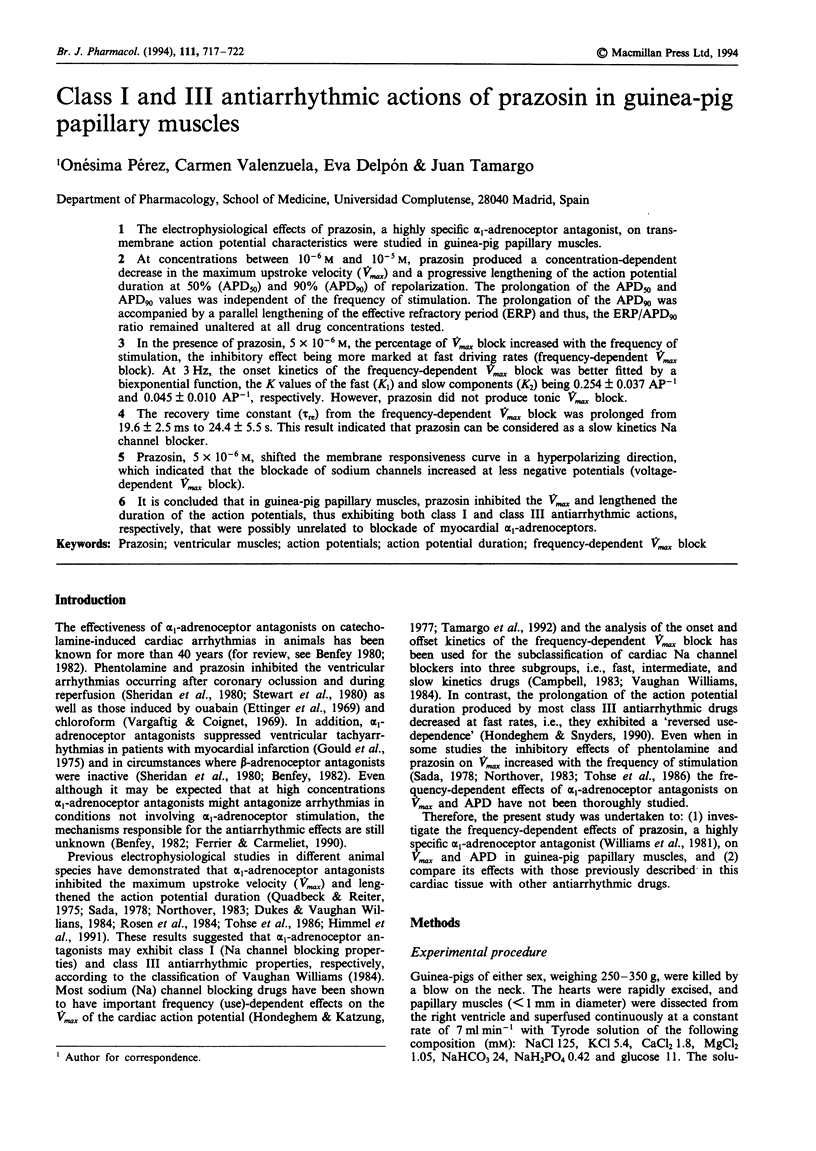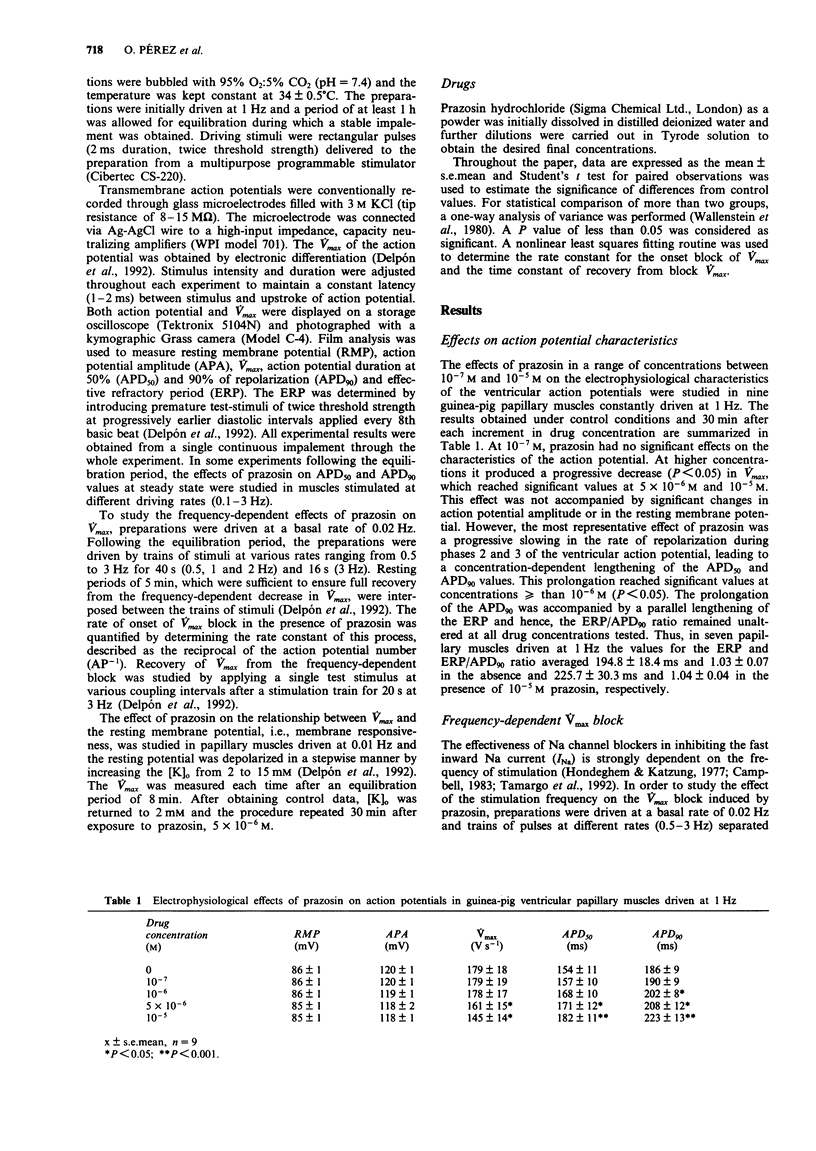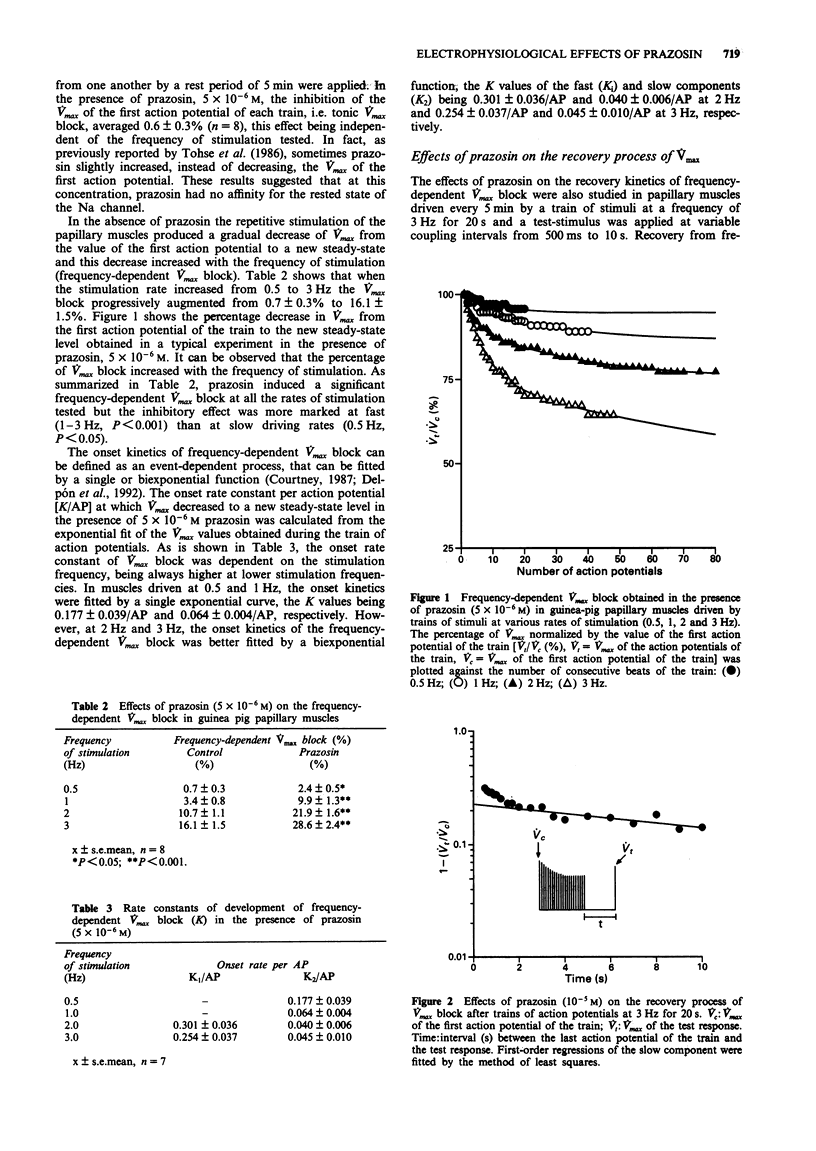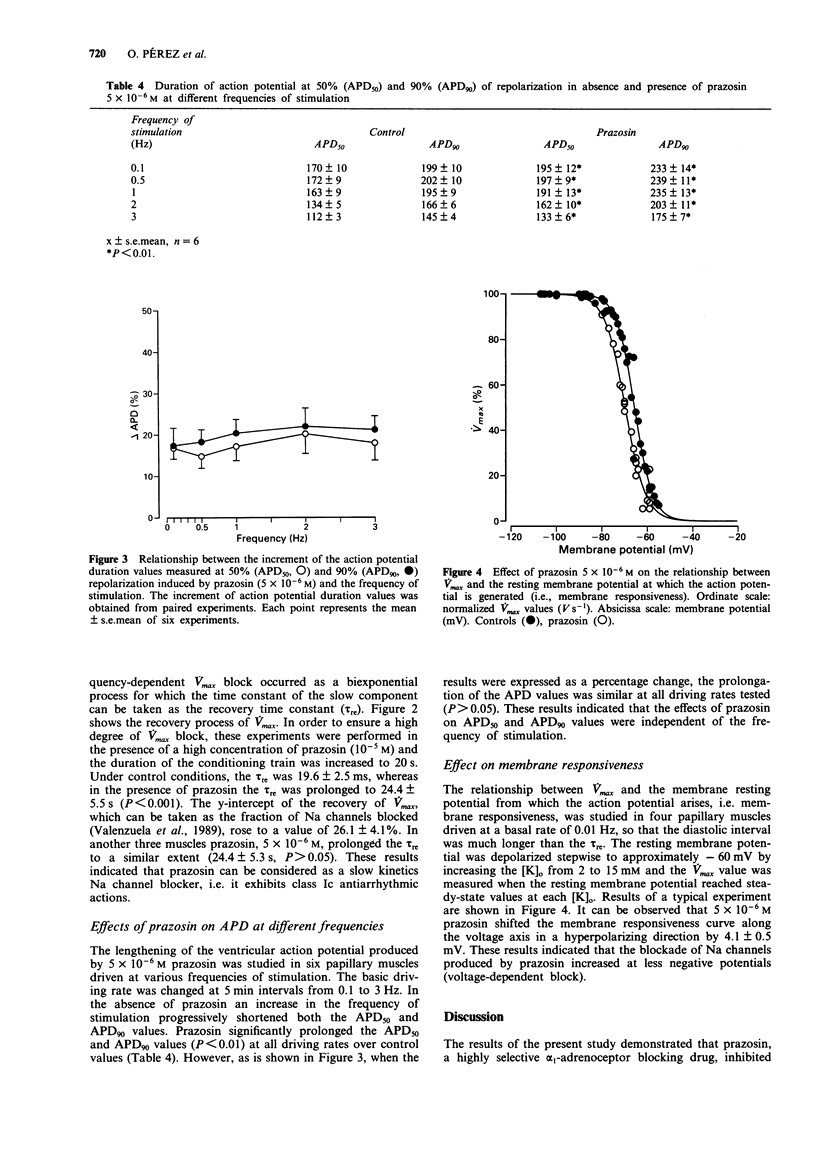Abstract
1. The electrophysiological effects of prazosin, a highly specific alpha 1-adrenoceptor antagonist, on transmembrane action potential characteristics were studied in guinea-pig papillary muscles. 2. At concentrations between 10(-6) M and 10(-5) M, prazosin produced a concentration-dependent decrease in the maximum upstroke velocity (Vmax) and a progressive lengthening of the action potential duration at 50% (APD50) and 90% (APD90) of repolarization. The prolongation of the APD50 and APD90 values was independent of the frequency of stimulation. The prolongation of the ADP90 was accompanied by a parallel lengthening of the effective refractory period (ERP) and thus, the ERP/APD90 ratio remained unaltered at all drug concentrations tested. 3. In the presence of prazosin, 5 x 10(-6) M, the percentage of Vmax block increased with the frequency of stimulation, the inhibitory effect being more marked at fast driving rates (frequency-dependent Vmax block). At 3 Hz, the onset kinetics of the frequency-dependent Vmax block was better fitted by a biexponential function, the K values of the fast (K1) and slow components (K2) being 0.254 +/- 0.037 AP-1 and 0.045 +/- 0.010 AP-1, respectively. However, prazosin did not produce tonic Vmax block. 4. The recovery time constant (tau re) from the frequency-dependent Vmax block was prolonged from 19.6 +/- 2.5 ms to 24.4 +/- 5.5 s. This result indicated that prazosin can be considered as a slow kinetics Na channel blocker. 5. Prazosin, 5 x 10(-6) M, shifted the membrane responsiveness curve in a hyperpolarizing direction, which indicated that the blockade of sodium channels increased at less negative potentials (voltage-dependent Vmax block).(ABSTRACT TRUNCATED AT 250 WORDS)
Full text
PDF





Selected References
These references are in PubMed. This may not be the complete list of references from this article.
- Benfey B. G. Cardiac alpha adrenoceptors. Can J Physiol Pharmacol. 1980 Oct;58(10):1145–1157. doi: 10.1139/y80-174. [DOI] [PubMed] [Google Scholar]
- Benfey B. G. Function of myocardial alpha-adrenoceptors. Life Sci. 1982 Jul 12;31(2):101–112. doi: 10.1016/0024-3205(82)90421-0. [DOI] [PubMed] [Google Scholar]
- Campbell T. J. Importance of physico-chemical properties in determining the kinetics of the effects of Class I antiarrhythmic drugs on maximum rate of depolarization in guinea-pig ventricle. Br J Pharmacol. 1983 Sep;80(1):33–40. doi: 10.1111/j.1476-5381.1983.tb11046.x. [DOI] [PMC free article] [PubMed] [Google Scholar]
- Courtney K. R. Quantitative structure/activity relations based on use-dependent block and repriming kinetics in myocardium. J Mol Cell Cardiol. 1987 Mar;19(3):319–330. doi: 10.1016/s0022-2828(87)80599-0. [DOI] [PubMed] [Google Scholar]
- Delpón E., Valenzuela C., Pérez O., Tamargo J. Electrophysiological effects of CRE-1087 in guinea-pig ventricular muscles. Br J Pharmacol. 1992 Oct;107(2):515–520. doi: 10.1111/j.1476-5381.1992.tb12776.x. [DOI] [PMC free article] [PubMed] [Google Scholar]
- Dukes I. D., Vaughan Williams E. M. Electrophysiological effects of alpha-adrenoceptor antagonists in rabbit sino-atrial node, cardiac Purkinje cells and papillary muscles. Br J Pharmacol. 1984 Oct;83(2):419–426. doi: 10.1111/j.1476-5381.1984.tb16502.x. [DOI] [PMC free article] [PubMed] [Google Scholar]
- Ettinger S., Gould L., Carmichael J. A., Tashjian R. J. Phentolamine: use in digitalis-induced arrhythmias. Canine experiments. Am Heart J. 1969 May;77(5):636–640. doi: 10.1016/0002-8703(69)90548-1. [DOI] [PubMed] [Google Scholar]
- Ferrier G. R., Carmeliet E. Effects of alpha-adrenergic agents on transient inward current in rabbit Purkinje fibers. J Mol Cell Cardiol. 1990 Feb;22(2):191–200. doi: 10.1016/0022-2828(90)91115-n. [DOI] [PubMed] [Google Scholar]
- Giles W. R., Imaizumi Y. Comparison of potassium currents in rabbit atrial and ventricular cells. J Physiol. 1988 Nov;405:123–145. doi: 10.1113/jphysiol.1988.sp017325. [DOI] [PMC free article] [PubMed] [Google Scholar]
- Himmel H. M., Glossmann H., Ravens U. Naftopidil, a new alpha-adrenoceptor blocking agent with calcium antagonistic properties: characterization of Ca2+ antagonistic effects. J Cardiovasc Pharmacol. 1991 Feb;17(2):213–221. doi: 10.1097/00005344-199102000-00006. [DOI] [PubMed] [Google Scholar]
- Hondeghem L. M., Katzung B. G. Time- and voltage-dependent interactions of antiarrhythmic drugs with cardiac sodium channels. Biochim Biophys Acta. 1977 Nov 14;472(3-4):373–398. doi: 10.1016/0304-4157(77)90003-x. [DOI] [PubMed] [Google Scholar]
- Hondeghem L. M., Snyders D. J. Class III antiarrhythmic agents have a lot of potential but a long way to go. Reduced effectiveness and dangers of reverse use dependence. Circulation. 1990 Feb;81(2):686–690. doi: 10.1161/01.cir.81.2.686. [DOI] [PubMed] [Google Scholar]
- Matsuura H., Ehara T., Imoto Y. An analysis of the delayed outward current in single ventricular cells of the guinea-pig. Pflugers Arch. 1987 Dec;410(6):596–603. doi: 10.1007/BF00581319. [DOI] [PubMed] [Google Scholar]
- Nattel S. Antiarrhythmic drug classifications. A critical appraisal of their history, present status, and clinical relevance. Drugs. 1991 May;41(5):672–701. doi: 10.2165/00003495-199141050-00002. [DOI] [PubMed] [Google Scholar]
- Northover B. J. A comparison of the electrophysiological actions of phentolamine with those of some other antiarrhythmic drugs on tissues isolated from the rat heart. Br J Pharmacol. 1983 Sep;80(1):85–93. doi: 10.1111/j.1476-5381.1983.tb11053.x. [DOI] [PMC free article] [PubMed] [Google Scholar]
- Quadbeck J., Reiter M. Adrenoceptors in cardiac ventricular muscle and changes in duration of action potential caused by noradrenaline and isoprenaline. Naunyn Schmiedebergs Arch Pharmacol. 1975;288(4):403–414. doi: 10.1007/BF00501285. [DOI] [PubMed] [Google Scholar]
- Rosen M. R., Weiss R. M., Danilo P., Jr Effect of alpha adrenergic agonists and blockers on Purkinje fiber transmembrane potentials and automaticity in the dog. J Pharmacol Exp Ther. 1984 Dec;231(3):566–571. [PubMed] [Google Scholar]
- Sada H. Effect of phentolamine, alprenolol and prenylamine on maximum rate of rise of action potential in guinea-pig papillary muscles. Naunyn Schmiedebergs Arch Pharmacol. 1978 Oct;304(3):191–201. doi: 10.1007/BF00507958. [DOI] [PubMed] [Google Scholar]
- Sheridan D. J., Penkoske P. A., Sobel B. E., Corr P. B. Alpha adrenergic contributions to dysrhythmia during myocardial ischemia and reperfusion in cats. J Clin Invest. 1980 Jan;65(1):161–171. doi: 10.1172/JCI109647. [DOI] [PMC free article] [PubMed] [Google Scholar]
- Silke B., Lakhani Z. M., Taylor S. H. Pharmacokinetic and pharmacodynamic studies with prazosin in chronic heart failure. J Cardiovasc Pharmacol. 1981 Mar-Apr;3(2):329–335. doi: 10.1097/00005344-198103000-00011. [DOI] [PubMed] [Google Scholar]
- Stewart J. R., Burmeister W. E., Burmeister J., Lucchesi B. R. Electrophysiologic and antiarrhythmic effects of phentolamine in experimental coronary artery occlusion and reperfusion in the dog. J Cardiovasc Pharmacol. 1980 Jan-Feb;2(1):77–91. doi: 10.1097/00005344-198001000-00009. [DOI] [PubMed] [Google Scholar]
- Tamargo J., Valenzuela C., Delpón E. New insights into the pharmacology of sodium channel blockers. Eur Heart J. 1992 Nov;13 (Suppl F):2–13. doi: 10.1093/eurheartj/13.suppl_f.2. [DOI] [PubMed] [Google Scholar]
- Tohse N., Nakaya H., Kanno M. Electrophysiological effects of amosulalol, a new alpha- and beta-adrenoceptor blocker, in isolated rabbit papillary muscles. Eur J Pharmacol. 1986 Jun 24;125(3):411–419. doi: 10.1016/0014-2999(86)90797-1. [DOI] [PubMed] [Google Scholar]
- Valenzuela C., Sanchez-Chapula J. Electrophysiologic interactions between mexiletine-quinidine and mexiletine-ropitoin in guinea pig papillary muscle. J Cardiovasc Pharmacol. 1989 Nov;14(5):783–789. doi: 10.1097/00005344-198911000-00016. [DOI] [PubMed] [Google Scholar]
- Vargaftig B., Coignet J. L. A critical evaluation of three methods for the study of adrenergic beta-blocking and anti-arrhythmic agents. Eur J Pharmacol. 1969 Apr;6(1):49–55. doi: 10.1016/0014-2999(69)90064-8. [DOI] [PubMed] [Google Scholar]
- Vaughan Williams E. M. A classification of antiarrhythmic actions reassessed after a decade of new drugs. J Clin Pharmacol. 1984 Apr;24(4):129–147. doi: 10.1002/j.1552-4604.1984.tb01822.x. [DOI] [PubMed] [Google Scholar]
- Wallenstein S., Zucker C. L., Fleiss J. L. Some statistical methods useful in circulation research. Circ Res. 1980 Jul;47(1):1–9. doi: 10.1161/01.res.47.1.1. [DOI] [PubMed] [Google Scholar]
- Williams R. S., Dukes D. F., Lefkowitz R. J. Subtype specificity of alpha-adrenergic receptors in rat heart. J Cardiovasc Pharmacol. 1981 May-Jun;3(3):522–531. doi: 10.1097/00005344-198105000-00011. [DOI] [PubMed] [Google Scholar]
- Wood A. J., Bolli P., Simpson F. O. Prazosin in normal subjects: plasma levels, blood pressure and heart rate. Br J Clin Pharmacol. 1976 Feb;3(1):199–201. doi: 10.1111/j.1365-2125.1976.tb00592.x. [DOI] [PMC free article] [PubMed] [Google Scholar]


